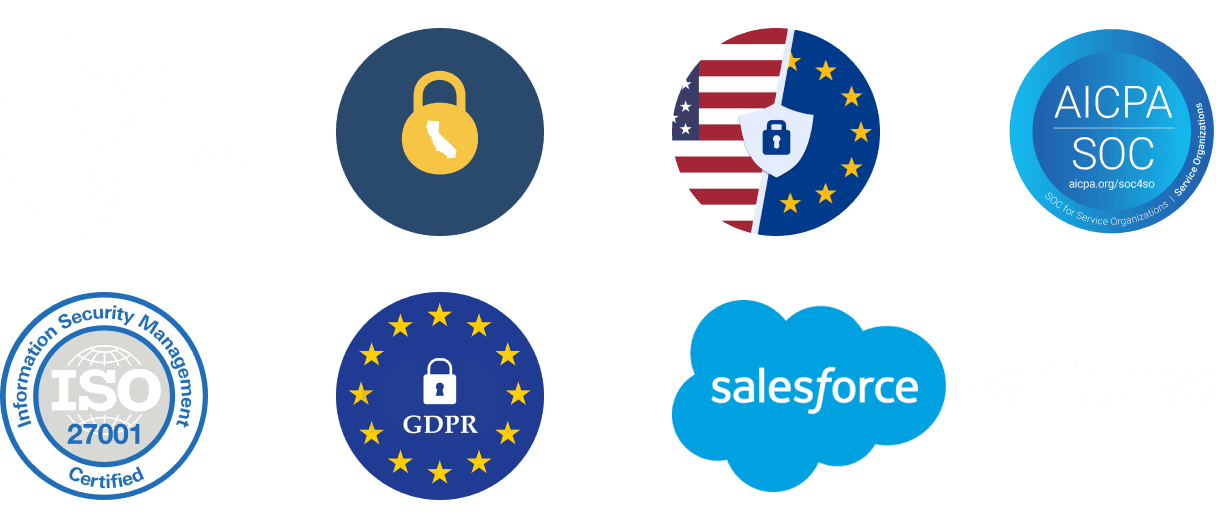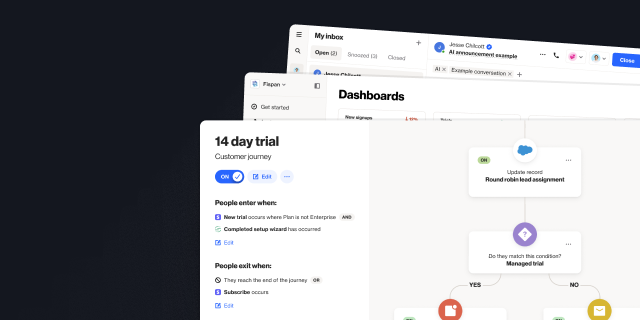12 audiences every SaaS business needs
Outline
- Introduction
- What are audiences?
- 12 audience types across the SaaS customer journey
- Lead Nurturing
- User Engagement
- User Retention
- User Expansion
- Final word
More like this:

Do you have a system for organizing your leads, prospects, customers and subscribers? Can you easily visualize different stages of the customer lifecycle and make informed, strategic decisions based on those stages? Is this visibility shared across marketing, sales, and customer support?
If you’re not answering ‘yes’ to the above questions, you may be missing out on valuable opportunities for growth.
In this blog, we will discuss 12 audience types and why you should create them using Ortto’s audiences feature.
What are audiences?
Ortto’s audiences feature helps you to organize and categorize your contacts in many ways, including by stages in the customer journey. Common audiences include subscribers, leads and customers, but audience types can vary depending on your organization’s needs.
In Ortto, contacts will be dynamically added to or removed from lists depending on the criteria they match, meaning your audiences are updated in real-time in your Ortto CDP.
Using audiences enables you to easily complete a number of activities: track a segment of people over time; manage subscription preferences; create campaigns for a specific audience, and so on.
12 audience types across the SaaS customer journey
One of the best ways to start building audiences is to look at them through the lens of the customer journey. We’re going to look at audience types at four phases of the customer journey: leads, new customers, retention, and expansion. For each audience, we’ll discuss why it is important and what can you can do with it.
Lead Nurturing
This phase is all about lead scoring and nurturing leads to conversion.
1. TOFU leads
Top of the funnel (TOFU) leads refers to all of the leads that come through your site, ads, events, etc. These are individuals and organizations who have shown an interest in your brand or offering in some way and have shared some basic contact information with you – typically their name, email address and/or phone number. Perhaps they subscribed to your newsletter, or watched a webinar, or downloaded a piece of content.
Leads sit at the top of the funnel, meaning they are aware of your business but are not yet ready to make a purchase. Your job is to build email and ad campaigns that educate them about your brand and establish greater awareness and trust.
Different organizations may have different ways of classifying new leads, but lead generation is the goal of every marketing team, so this audience is the biggest indicator of the success of marketing initiatives.
2. Hot leads
Hot leads are high-quality leads. They are leads that are close to conversion (perhaps determined by a product-qualifying action that they've taken during a free trial for example), or they could be leads that are exactly aligned with your ideal user, or they could be leads that the wider business has identified as dream users
Hot leads are prospects who are sitting at the middle of the funnel. They have realized that they need to address a certain problem and are exploring their options. The sales team must strike while the iron is hot and show them that your offering is the solution they have been looking for.
3. Demo requests
This is an audience of people who have requested a demo of your product or service. They are prospects at the bottom of the funnel, meaning they’re considering making a purchase and are trying you on for size. As well as giving them a demo of your product or service, send them case studies and user testimonials as well as competitor analysis to guide them to conversion.
4. On a trial
If you offer a free trial of your product or service, you should create an audience of people who are on that trial. Trials can span days, weeks or months, so this list will chop and change a lot, but it’s an important audience to keep an eye on.
You should send relevant communications throughout a user’s trial period to maintain engagement and usage. For example, if someone has just started their free trial, you could send them helpful guides and how-tos for getting the most out of the product or service. Half-way through the trial, you could check in with the user to ask if they have any questions and share more educational content to help them reach value realization. When the person is nearing the end of the trial, let them know how many days they have left, and remind them what full access to your product or service can offer them, and give them a pricing page so they are aware of next steps. This is the point at which sales could reach out to check in with how they’re going.

5. Subscribers
Subscribers are people who are signed up to your newsletter or other email list. The audience can be made up of hot leads (prospects), cold leads, paying users, partners, and your blog audience.
It’s important to put different subscriber types in their own audiences, because not everyone who shares their contact information with you should receive every regular email you send. To make this list, contacts must have explicitly opted-in to receive this communication. Not honoring this by sending your newsletter to people who are not expecting it can break trust, cause frustration, and on a technical level, may harm your email deliverability (that is, the likelihood your emails will land in the inbox and not the spam folder). Read more about email deliverability in our blog.
Having audiences for different subscriber types means you can cross-examine leads and conversions to determine the effectiveness of your email strategy.
User Engagement
So, you have successfully converted your leads into new users. Now you have to help them reach that all-important value realization moment.
6. Free users
This audience is made up of free-tier users. These are users. who don’t pay anything for partial access to your offering. Keeping an eye on this audience is important for upgrade, cross-sell and upsell opportunities. For example, if you have a usage limit for your free plan, and the user is getting close to that limit, you could send an email like, “You’ve almost reached your usage limit for the month. Chat to us to upgrade your plan so you don’t disrupt your activity.” Setting up automated communications like this one is easy with Ortto’s custom activities feature – find out more in here.
7. Onboarding
This audience is for users in their onboarding period. The aim of onboarding is to help the users reach their “aha” moment as quickly as possible. To help this, you can boost engagement by congratulating users for completing various tasks and onboarding milestones. You may also send them educational content such as guides and how-tos to help them reach value realization.
8. All users
It’s also a good idea to create an audience of all users for product updates and announcements. You can always filter your audience to get more granular with your messaging, but having an all users audience is a good starting point.
User Retention
These users are well-versed in your product or service, but it’s your job to keep them engaged and satisfied.
9. Paying users
This audience is for your paying users. With this audience you can do a lot of things: keep them updated on product/company news; ask for feedback on their product usage; send promotional offers and discounts, and more.
You could also filter this audience based on the products or features they are using, and if you are announcing a new product or feature you know they would be interested in, you can create hype by sending them on a nurture journey about the new product or feature.
10. Slipping users
It’s a good idea to create an audience of users whose engagement is falling. Ortto users can measure engagement scores by setting up variables and using filters to create segments like ‘3 stars’ or ‘low engagement’.
By identifying your unengaged users you can implement strategies to reduce churn – that is, the percentage of users that stopped using your product after a set period of time. The lower your churn rate, the higher your user retention.
No matter what your churn rate is, you should make continuous improvements to lower it by engaging your users during every stage of the customer journey.
11. Highly engaged / top users
Just as you should create an audience of users whose engagement is slipping, you should also create one for users who are highly engaged or have a high MRR or CLV.
In this audience you’ll find your brand advocates – the users that spread positive word about your product or service to their friends, family, colleagues and on social media. Harness this advocacy by asking them to participate in case studies and leave online reviews.
This audience can also be beta testers for new features you are releasing.
Be sure to maintain the high engagement of this group by sending them promotional offers or merchandise as ‘thank-you’ for their continued business as they usually contribute the largest amount to your overall revenue.
You can also see what actions and behaviors these users have in common and then use nudge marketing to encourage your slipping users to take similar actions.
User Expansion
This phase is about finding and acting on opportunities for growth.
12. Expansion opportunities
This audience is for users who are taking actions or nearing usage limites that indicate they may expand soon. Being able to recognize this tipping point is crucial, because if this user is not aware that they may soon lose access to your platform because they have hit usage limits, it may cause mass business disruption for them.
On the other hand, they may not know that you can cater for their growth and, unless you intervene and educate them, they could begin market research to find another platform or service to switch to. By tracking your expanding audience, you can send the right message in the right moment to keep them onboard and help them upgrade their account seamlessly.
Final word
Creating audiences is just the beginning. Start with these audiences based on your user’s journey and grow from there.


“We were looking for a solution that was really easy to use, didn’t require a tech team, and would have a robust integration with Salesforce so we could trigger sales communications in a smarter way. Nobody else out there has what Ortto has.”

Try Ortto today
Build a better journey.

Product
Pricing
Solutions
Features
About
Resources
Ortto for
Templates
Integrations








